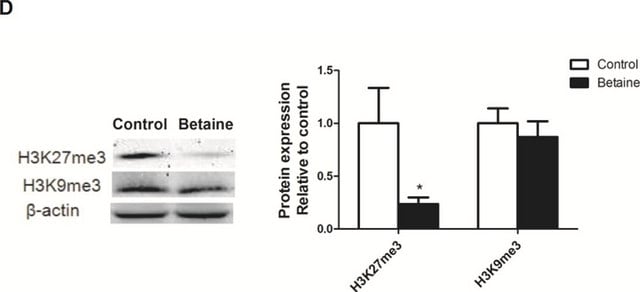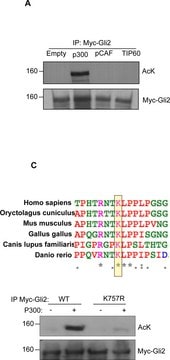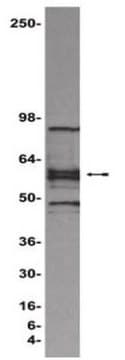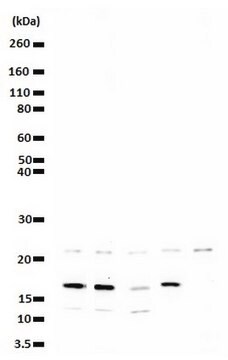17-600
ChIPAb+ CREB - ChIP Validated Antibody and Primer Set, rabbit monoclonal
culture supernatant, clone NL904, from rabbit
Synonym(s):
active transcription factor CREB, cAMP responsive element binding protein 1, cAMP-response element-binding protein-1, cAMP-responsive element-binding protein 1, transactivator protein
About This Item
Recommended Products
biological source
rabbit
Quality Level
antibody form
culture supernatant
clone
NL904, monoclonal
species reactivity
mouse, rat, human
manufacturer/tradename
ChIPAb+
Upstate®
technique(s)
ChIP: suitable
western blot: suitable
isotype
IgG
NCBI accession no.
UniProt accession no.
shipped in
dry ice
Gene Information
human ... CREB1(1385)
Related Categories
General description
The ChIPAb+ CREB, antibody/primer set includes the CREB, antibody, a negative control antibody (purified rabbit IgG), and qPCR primers which amplify a 64 bp region flanking the CRE of the human cFos gene. The CREB and negative control cultured supernatant are supplied in a scalable "per ChIP" reaction size and can be used to functionally validate the precipitation of CREB associated chromatin.
The qPCR primers included flank the CREB binding site in human NR4A2 promoter.
Specificity
Immunogen
Application
Representative lot data.
Sonicated chromatin prepared from 293T cells (5 X 106 cell equivalents per IP) was subjected to chromatin immunoprecipitation using 10 µL of either a negative supernatant, or CREB antibody and the Magna ChIP® A Kit (Cat. # 17-610).
Successful immunoprecipitation of CREB-associated DNA fragments was verified by qPCR using cFos downstream 4Kb (negative) and cFos CRE (positive) (Figure 2). Data is presented as percent input of each IP sample relative to input chromatin for each amplicon and ChIP sample as indicated.
Please refer to the EZ-Magna A ChIP (Cat. # 17-408) or EZ-ChIP (Cat. # 17-371) protocol for experimental details.
Western Blot Analysis:
Representative lot data.
HeLa nuclear extract was resolved by electrophoresis, transferred to nitrocellulose and probed with anti-CREB, clone NL904 (1:8,000 dilution)
Proteins were visualized using a goat anti-rabbit secondary antibody conjugated to HRP and a chemiluminescence detection system.
Arrow indicates CREB (~43 kDa).
Epigenetics & Nuclear Function
Chromatin Biology
Packaging
Components
Negative Control Supernatant: Part No. CS203202. One vial containing 250 μL of cultured supernatant containing 0.05% sodium azide. Store at -20°C.
ChIP Primers cFos CRE: Part No. CS203203. One vial containing 75 μL of 5 μM of each primer specific for the cFos CRE. Store at -20°C.
FOR: GGC CCA CGA GAC CTC TGA GAC A
REV: GCC TTG GCG CGT GTC CTA ATC T
Quality
Sonicated chromatin prepared from 293T cells (5 X 106 cell equivalents per IP) were subjected to chromatin immuno-precipitation using 10 µL of either a negative control cultured supernatant, or CREB antibody and the Magna ChIP® A Kit (Cat. # 17-610). Successful immunoprecipitation of CREB-associated DNA fragments was verified by qPCR using Control Primers (Figure 1).
Please refer to the EZ-Magna ChIP A (Cat. # 17-408) or EZ-ChIP (Cat. # 17-371) protocol for experimental details.
Target description
Physical form
Storage and Stability
Analysis Note
Includes negative control cultured supernatant and primers specific for of human cFos CRE.
Legal Information
Disclaimer
Storage Class Code
10 - Combustible liquids
Certificates of Analysis (COA)
Search for Certificates of Analysis (COA) by entering the products Lot/Batch Number. Lot and Batch Numbers can be found on a product’s label following the words ‘Lot’ or ‘Batch’.
Already Own This Product?
Find documentation for the products that you have recently purchased in the Document Library.
Our team of scientists has experience in all areas of research including Life Science, Material Science, Chemical Synthesis, Chromatography, Analytical and many others.
Contact Technical Service








